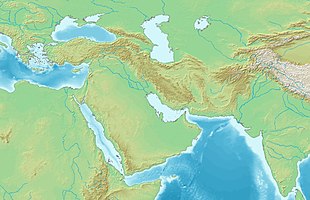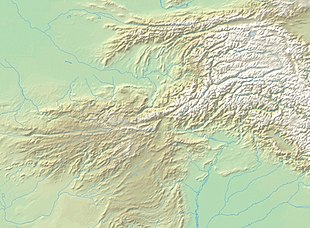Tokharistan
It has been suggested that this article be merged into Bactria. (Discuss) Proposed since November 2020. |
Tokharistan | |
|---|---|
 TOKHARISTAN WESTERN TURKS EMPIRE OF HARSHA BYZANTINE EMPIRE | |
| Capital | Balkh |
| Historical era | Early Middle Ages |
| Today part of | Afghanistan, Uzbekistan, Tajikistan |

Tokharistan (formed from "Tokhara" and the suffix -stan meaning "place of" in Persian) is an ancient Early Middle Ages name given to the area which was known as Bactria in Ancient Greek sources.
Today, Tokharistan is fragmented between Uzbekistan, Tajikistan and Afghanistan, but it was recognized as a single unit by the Chinese Empire in the 7th and 8th century CE, as a region of the Protectorate General to Pacify the West (安西大都護府).[4]
Names of Tokharistan[]
Several languages have used variations of the word "Tokhara" to designate the region:
- Tokharistan may appear in ancient India sources as the Kingdom of Tushara, to the northwest of India. "Tushara" is the Sanskrit word for "snowy" "frigid", and is known to have been used to designate the country of Tukhara.[5] In Sanskrit, it became तुखार (Tukhāra)
- In ancient Greek, the name was Tokharoi (Ancient Greek: Τόχαροι ) or Thaguroi.[6]
- Tochari for Latin historians.[7]
- The name "Tokhara" appeared in the 4th century CE, in Buddhist texts, such as the Vibhasa-sastra.
- In Tibetan, the name for the region was Thod-kar or Tho-gar.[6][8]
- The name appears in Chinese as Tukhara (覩货罗 Duhuoluo or 吐火罗 Tuhuoluo)[9] "Tokhara" was known in Chinese sources as Tuhuluo (吐呼羅) which is first mentioned during the Northern Wei era (386-534 CE).[10] In the Tang dynasty, the name is transcribed as Tuhuoluo (土豁羅). Other Chinese names are Doushaluo 兜沙羅, Douquluo 兜佉羅 or Duhuoluo 覩貨羅.
- In Khotanese, Ttaugara; in Uigurian, Twghry; in Armenian, T'ukri-k'.[6]
Ethnicities[]
Several portraits of ambassadors from the region of Tokharistan are known from the Portraits of Periodical Offering of Liang, originally painted in 526-539 CE. They were at that time under the overlordship of the Hephthalites, who led the embassies to the Southern Liang court in the early 6th century CE.

Kabadiyan ambassador to the Chinese court of Emperor Yuan of Liang in his capital Jingzhou in 516–520 CE, with explanatory text. Portraits of Periodical Offering of Liang, 11th century Song copy. The ambassador accompanied the Hephthalites to China.
So-called "Tocharians" in the Tarim Basin[]
The name of "Tocharians" was mistakenly applied by early 20th century authors to the Indo-European people of the Tarim Basin, from the areas of Kucha and Agni. These scholars mistakenly thought that these Indo-European people had originated in Tokharistan (Bactria), hence the name "Tocharian" they gave them. This naming has remained, although the Indo-European people of the Tarim Basin probably referred to themselves as Agni, Kuči and Krorän.[11][12]
Geography[]
Geographically, Tokharistan corresponds to the upper Oxus valley, between the mountain ranges of the Hindu-Kush to the south and the Pamir-Alay to the north.[4] The area reaches west as far as the Badakshan mountains, south as far as Bamiyan.[4] Arab sources considered Kabul as part of the southern border of Tokharistan, and Shaganiyan as part of its northern border.[4] In a narrow sense, Tokharistan may only refer to the region south of the Oxus.[4] The region used the East Iranian Bactrian language, which was current from the 2nd to the 9th century CE.[4]
The most important city of Tokharistan was Balkh, which was at the center of the trade between Iran (the Sasanian Empire) and India.[4]
The region of Tokharistan had been outside of Sasanian control for the three centuries preceding the Muslim conquest of Persia in 633-651 CE.[4] During that time, Tokharistan was under the rule of dynasties of Hunnish or Turkic origin, such as the Kidarites, the Alchon Huns and the Hephthalites.[4] At the time of the Arab conquest, Tokharistan was under the control of the Western Turks, through the Tokhara Yabghus.[4]
References[]
- ^ "The account herewith quoted as 3.5. shows that this king of Tokhara had political power to control the principalities belonging to the Governors-General to the north and the south of the Hindukush, not to mention the Yuezhi Governor General." in Kuwayama, Shoshin (2005). "Chinese Records on Bamiyan: Translation and Commentary". East and West. 55 (1/4): 153, 3–5. ISSN 0012-8376. JSTOR 29757642.
- ^ Detailed list of vassal cities and regions in ancient Chinese sources: Taishan, Y. U. (2012). 歐亞學刊 新3辑 (Eurasian Studies III): Records Relevant to the Hephthalites in Ancient Chinese Historical Works. 中華書局. p. 250.
- ^ Kuwayama, Shoshin (2005). "Chinese Records on Bamiyan: Translation and Commentary". East and West. 55 (1/4): 143–144. ISSN 0012-8376. JSTOR 29757642.
- ^ Jump up to: a b c d e f g h i j Akasoy, Anna; Burnett, Charles; Yoeli-Tlalim, Ronit (14 December 2016). Islam and Tibet – Interactions along the Musk Routes. Routledge. p. 51. ISBN 978-1-351-92605-8.
- ^ "Tushara ( snowy , frigid ) and Tushkara are used as equivalents of Tukhara" in Tchouang, Hiuan. Chinese Accounts of India. Susil Gupta. p. 103.
- ^ Jump up to: a b c "The population was called by the Greeks Tokharoi, Thaguroi; by the Romans Tochar; or Thogarii (in Sanskrit, Tukhara; in Tibetan, Thod-kar or Tho-gar; in Khotanese, Ttaugara; in Uigurian, Twghry; in Armenian, T'ukri-k'" in Diringer, David (1948). Alphabet A Key To The History Of Mankind. p. 348.
- ^ Namba Walter, Mariko (October 1998). "Tokharian Buddhism in Kucha: Buddhism of Indo-European Centum Speakers in Chinese Turkestan before the 10th Century C.E." (PDF). Sino-Platonic Papers. 85: 2–4.
- ^ Religions and Trade: Religious Formation, Transformation and Cross-Cultural Exchange between East and West. BRILL. p. 81. ISBN 978-90-04-25530-2.
- ^ For 覩货罗 as "Tokharistan" see 冯承钧学术著作集中 (in Chinese). Beijing Book Co. Inc. June 2015. p. 175. ISBN 978-7-999099-49-9.
- ^ "In the Record of the Northern - Wei Dynasty it is transcribed as T'u-hu-luo" in Chinese Monks in India: Biography of Eminent Monks who Went to the Western World in Search of the Law During the Great Tʻang Dynasty. Motilal Banarsidass. 1986. p. 7. ISBN 978-81-208-0062-5.
- ^ Namba Walter, Mariko (October 1998). "Tokharian Buddhism in Kucha: Buddhism of Indo-European Centum Speakers in Chinese Turkestan before the 10th Century C.E." (PDF). Sino-Platonic Papers. 85: 2.
- ^ Diringer, David (1948). Alphabet A Key To The History Of Mankind. pp. 347–348.
- Bactria
- Historical regions of Afghanistan
- Historical regions
- Regions of Tajikistan
- Regions of Uzbekistan
- States and territories disestablished in the 8th century
- States and territories established in the 4th century



